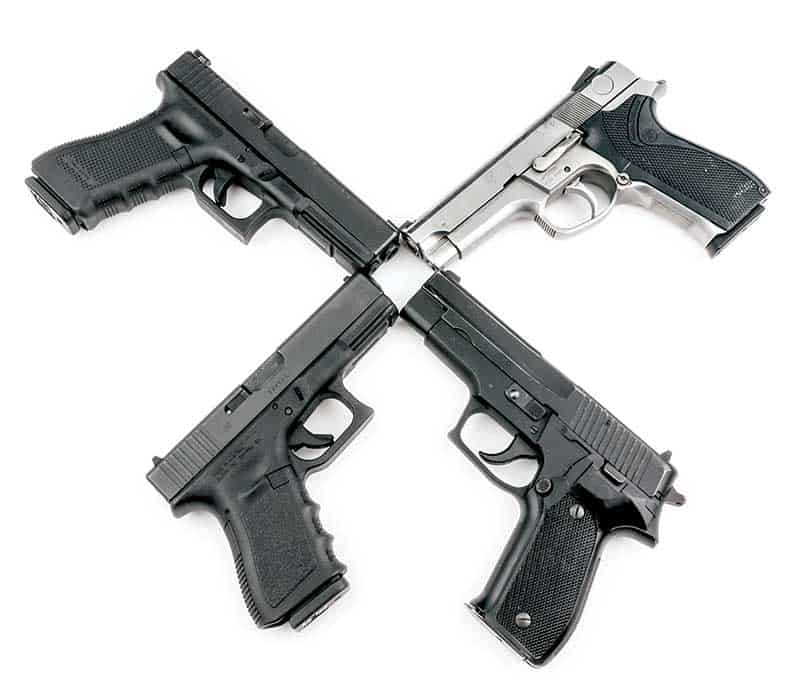Who Should Choose
the Gun?
Department or Officer?
As long as any of us have been alive, some law enforcement agencies have mandated a “company gun” policy of one duty sidearm for all armed personnel, while others have had a PODA (privately owned, department approved) policy. Each policy has strengths and weaknesses.
Standard Issue Pros And Cons
In favor of standard issue, more of the same gun can lower price with volume. The agency’s armorers only need to be certified to work on one platform. This was one reason cited by the FBI in their recent policy change, soon to be completed if it hasn’t been already, of disallowing grandfathered traditional DA autos, .40s and .45s. The plan is to consolidate on one gun for everyone, a 9mm Gen5 GLOCK. Inventories of magazines, ammo, holsters and spare parts are all greatly simplified.
One would think a single standard platform would make things easier for instructors, too, but that’s only partially true. Yes, the instructor is spared having to say the decocking lever works this way on one pistol and differently on another, but the fact is with the prevalence of striker-fired guns today, most everyone can get by with a reasonably standard manual of arms.
The flip side is more cops flunk qualification because the gun doesn’t fit their hand than because they get confused about where the controls are. Shooting a poorly fitting gun is like driving a car whose seat has been adjusted for someone with different size arms, body and legs than you. You may get to where you can drive it acceptably, but you’ll never be able to reach your full potential in operating it.
One unheralded reason for the success of the modern polymer-frame, striker-fired duty pistol is interchangeable grip and backstrap panels, allowing greater hand size adaptability. This is also a significant factor in the meteoric rise in LE adoptions of the SIG P320, with its advanced grip modularity.
PODA Pros And Cons
Even when NYPD was “all .38 Special service revolver,” members of the service had the choice of Colt or S&W and later, Ruger. Today it’s 9mm auto only for duty wear, the last couple hundred grandfathered six-shooters having left the streets years ago. However, the officers (who buy their own pistols through the department) have a choice of GLOCK 17 or 19, SIG P226 DAO, and the now-discontinued S&W 5906. Heads of the NYPD Firearms Training Unit told me one reason for this was protection against a brand’s quality control. If one started slipping, the department wouldn’t be held hostage by a single gun manufacturer.
There’s a theory cops will take better care of their own guns than the department’s, just as officers with take-home cars seem to abuse them less and maintain them better than those who draw their vehicles from the motor pool. The fit issue favors the personally owned gun.
So does the caliber question. No matter how much the ghost of Jeff Cooper may frown, there are cops who don’t shoot as well with their issue .45 as they could with their own 9mm. Conversely, some cops don’t accept the FBI mantra with modern ammo 9mm equals .45 and would be more confident with the larger caliber. In the Chicago PD, today’s recruits are issued a 9mm GLOCK 17, but after passing probation have the option of going up to a .40 or .45. LAPD issues 9mm S&W M&Ps or GLOCKs at the Academy, but many officers carry optional .40s and .45s, including 1911s. LAPD’s two highest-risk units, SWAT and the Special Investigation Section, were still requiring .45s for those teams last I knew.
A downside of the personal duty gun is seen when departments get slack on the “approved” part. I recall a patrolman I knew in the ’70s who was carrying a Spanish copy of a Smith & Wesson .32 revolver on duty until the chief got wind of it and issued him a Model 10 S&W .38 Special. The department firearms instructors should have a major say in what is and isn’t approved. And yes, a PODA policy will demand a bit more work from the armorers and instructors. But if the nation’s three largest municipal police departments — NYPD, Chicago PD and LAPD — can handle it, well …
Confidence and competence intertwine. The officer will most likely be alone when he or she fights to survive. They should have the gear giving the individual officer the greatest confidence and competence.







